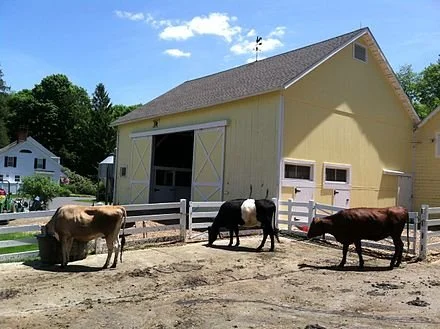At a dairy farm in Redding, Conn., an exurban town. The state’s two biggest agriculture sectors are horticulture and dairy.
Vermont’s coat of arms reminds us of how important farming, especially dairy, has been to the Green Mountain State. But in the first half of the 19th Century, raising Merino sheep for wool was the big thing.
Produce from Mack’s Apples, a farm in Londonderry, N.H., that goes back to 1732.
Adapted from Robert Whitcomb’s “Digital Diary,’’ in GoLocal24.com
The New England State Food System Planners Partnership has looked into how the region could boost its food production so that it could produce 30 percent of the food it consumes by 2030. We’ve been harvesting less than about 20 percent of the food we eat.
Wouldn’t it be nice if the six states could grow enough vegetables and grains, and catch and grow enough animal protein (especially finfish and shellfish), so that it wouldn’t have to import nearly as much from far away, much of it from huge agribusinesses, with the accompanying energy and other costs. In so doing we’d get fresher food, employ many more New Englanders, reduce fossil-fuel burning and in some places get cheaper stuff to eat.
Something else to consider: Global warming and all its associated issues are expected to hit hard in such huge agribusiness regions as the Midwest, Florida and California’s Central Valley. New England’s climate outlook is much less forbidding. In any event, we may have to grow more of our food.
Of course, we think about this more in the summer, when we enjoy locally grown super-fresh vegetables. But an increasing number of large indoor “farms’’ are slowly adding to our locally grown year-round vegetable crops. And the warming climate might substantially extend our growing season.
Most of New England’s farmland is in the three northern states, which are largely rural. That won’t change, but we ought to encourage more agriculture near cities in Massachusetts, Rhode Island and Connecticut. That would reduce shipping costs. Many farms in Europe and elsewhere abroad are remarkably close to large and small cities.
Where to find the land? One is to use some of the open space (parking lots, etc.) freed up by the demise of many shopping centers in the Age of Amazon. Of course, much of this acreage would require extensive remediation to make it safe for agriculture. Then there’s cutting down trees in some places to convert to farmland. There used to be much, much more open land devoted to farming (especially for dairy cows) in New England before the opening up of the flat and fertile farmland in the Middle West, California’s Central Valley and elsewhere. That made many of our region’s farms, most of which were small because of the hilly and rocky terrain in much of our region, economically uncompetitive. (There were some big exceptions, most notably the Connecticut River Valley.) Thus New England is far more wooded than it was 150 years ago.
But we’d need studies on how reducing our woodlands to plant food might worsen global warming. Trees absorb huge amounts of carbon dioxide.
There’s been a bit of revival in raising cattle and pigs in some parts of New England for high-end markets. But raising such animals for slaughter is, in food-production and nutrition terms, very wasteful compared to raising plants. Most Americans still love eating red meat, though many who know the health drawbacks and/or have seen the horrific slaughtering process have given it up.
Then there’s aquaculture, a source of high-quality protein that could be greatly expanded. It was mild good news that Perry Raso, the South Kingstown, R.I. restaurateur and shellfish farmer, has reportedly received approval to modestly expand his farming.
The National Oceanic and Atmospheric Administration is getting $3.3 billion under the Biden Administration’s Inflation Reduction Act to invest in science-based management and conservation of marine resources amidst global warming. Let’s hope that some of this money promotes coastal aquaculture.
Bravo to the New England State Food System Planners Partnership as it presses for greater regional food independence – good for public health, our economy and the environment.
Enjoy the sweet corn, tomatoes and other treasures of the New England summer. Patronize those farmstands.













